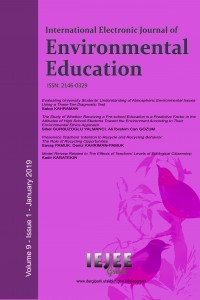Helping Students Comprehend the Needs of Living Things in Their Natural Habitats Through Creative Drama Technique: A Musical Chair Game
Helping Students Comprehend the Needs of Living Things in Their Natural Habitats Through Creative Drama Technique: A Musical Chair Game
This study aimed to develop secondary school seventh-grade students’ awareness of natural habitats and the interactions among living things, as well as reveal their views on the problems encountered. The study was designed as a case study, a qualitative perspective and conducted with 64 students from a private school during the 2017–2018 academic year. Three open-ended questions were posed in semi-structured interviews and the students’ responses were analyzed using the content analysis technique. The results revealed that the students developed an awareness of natural habitats and the interaction among living things. The students proposed the protection of living things, protection and reproduction of habitats, transportation of living things to more suitable habitats, and protection of the natural balance, as solutions to the problems that might arise in natural habitats.
___
- Bailey, S. 1994. The Ecogame. Risley, Warrington and Cheshire: BNFL Education Unit.
- Braund, M., & Ahmed, Z. (2018). Drama as physical role-play: actions and outcomes for life science lessons in South Africa. Journal of Biological Education, 1-10.
- Bogner, F. X. (1998) The influence of shortterm outdoor ecology education on long-term variables of environmental perspectives, Journal of Environmental Education, 29(4), 17–29.
- Carlsson, B. 2002. “Jag Vill Vara Kol!-Ett Fotosyntetiskt Dramaspel.” Miljödidaktiska Txter, Lärarutbildningen, Malmö, Högskola 4: 10–27.
- Creswell, J.W., & Clark, P. (2011). Designing and conducting mixed methods research. Thousve Oaks: Sage.
- Doğan, Y., Saraç, E. ve Çiçek, Ö. (2017). Ortaokul öğrencilerinin çevre sorunları, nedenleri ve çözümlerine yönelik algıları. International Journal Of Eurasia Social Sciences, 8(29), 787-804).
- Erdoğan, M. (2011). Ekoloji temelli yaz doğa eğitimi programının ilköğretim öğrencilerinin çevreye yönelik bilgi, duyuşsal eğilimler ve sorumlu davranışlarına etkisi. Kuram ve Uygulamada Eğitim Bilimleri, 11(4), 2223-2237.
- Erdoğan, M., & Özsoy, A. M. (2007). Graduate students’ perspectives on the human and environment relationship. Türk Fen Eğitimi Dergisi, 4(2), 21-30.
- Erten, S. (2004). Çevre Eğitimi ve Çevre Bilinci Nedir, Çevre Eğitimi Nasıl Olmalıdır? Çevre ve İnsan Dergisi, Ankara: Çevre ve Orman Bakanlığı Yayın Organı.
- Heather, P. (1999). Enperiential environmental education for primary aged-children (ERIC Document Reproduction Service No. ED 471 723).
- Karakaya, F., & Yılmaz, M. (2017). Environmental ethics awareness of teachers. International Electronic Journal of Environmental Education, 7(2), 105-115.
- Karakaya, F., Avgin, S. S., & Yilmaz, M. (2017). Environmental literacy dimensions of pre-service teachers. Üniversitepark Bülten, 6(1), 95-108.
- Karakaya, F., Avgın, S. S., Gömlek, E., & Balık, M. Nature relatedness of pre-service teachers. Turkish Journal of Education, 6(2),79-87.
- Martin, S. C. (2003). The influence of outdoor schoolyard experiences on students’ environmental knowledge, attitudes, behavior and confort level. Journal of Elementary Science Education, 15(2), 51-63.
- MEB. (2018). İlköğretim Fen Bilimleri Dersi (3,4,5,6,7 ve 8. Sınıflar) Öğretim Programı. Ankara: MEB Yayınevi. http://mufredat.meb.gov.tr/Dosyalar/201812312311937-FEN%20B%C4%B0L%C4%B0MLER%C4%B0%20%C3%96%C4%9ERET%C4%B0M%20PROGRAMI2018.pdf
- Miles, M.B., & Huberman, A.M. (2015). Nitel veri analizi. (1.baskı) (Ed. S. Altun Akbaba ve A. Ersoy). Ankara: Pegem Akademi.
- Ødegaard, M. 2001. The Drama of Science Education. How Public Understanding of Biotechnology and Drama as a Learning Activity May Enhance a Critical and Inclusive Science Education. Unpublished Dr. Scient. diss., University of Oslo, Norway.
- Özdemir, O. (2010). Doğa deneyimine dayalı çevre eğitiminin ilköğretim öğrencilerinin çevrelerine yönelik algı ve davranışlarına etkisi. Pamukkale Üniversitesi Eğitim Fakültesi Dergisi, 27(27), 125-138.
- Reece, J.B., Urry, L.A., Cain, M.L., Wasserman, S.A., Minorsky, P.V., & Jackson, R.B. (2013). Campbell Biyoloji, (E. Gündüz, İ. Türkan, Çev.). Ankara, Palme Yayıncılık.
- Sadava, D., Hillis, M.D., Heller, H.C., & Berenbaum, M.R. (2014). Yaşam bilimi biyoloji. (E. Gündüz, İ. Türkan, Çev.). Ankara, Palme Yayıncılık.
- Simon, E.J., Dickey, J.L., Hogan, K.A., & Reece, J.B. (2017). Campbell temel biyoloji. (E. Gündüz, İ. Türkan, Çev.). Ankara, Palme Yayıncılık.
- Smith, M.T. and Smith, L.R. (2009). Elements of ecology, international edition, Pearson Benjamin Cummings, 649p, USA.
- Withgott, J., Brennan, S. (2008). Environment The Science Behind The Stories, Pearson Benjamin Cummings, USA, 681 pp.
- Yardımcı, E., & Bağcı-Kılıç, G. (2010). Çocukların gözünden çevre ve çevre sorunları. İlköğretim Online, 9(3), 1122-1136.
- Yıldız, K., Sipahioğlu, Ş., & Yılmaz, M. (2009). Çevre Bilimi ve Eğitimi. Ankara: Gündüz Eğitim ve Yayıncılık.
- Yılmaz, O., Samsunlu, Ö., & Peker, R. (2017). Üniversite öğrencilerinin çevre sorunlarına ilişkin görüşleri: Isparta İli Örneği. Mehmet Akif Ersoy Üniversitesi Eğitim Fakültesi Dergisi, (43), 283-301.
- Başlangıç: 2010
- Yayıncı: Sibel BALCI
Sayıdaki Diğer Makaleler
Mehmet YILMAZ, Osman ÇİMEN, Ferhat KARAKAYA, Merve ADIGÜZEL
Recycling Awareness Education: Its Impact On Knowledge Levels Of Science Teacher Candidates
Environmental Awareness and Practices of Science Students: Input for Ecological Management Plan
Danilo ROGAYAN, Eveyen El Elyonna D. NEBRIDA
Is Nuclear Power Acceptance Related To Environmental Literacy In Turkey?
Melike YAVUZ-TOPALOĞLU, Eda DEMİRHAN, Elif ATABEK-YİĞİT
Investigation of Ecological Footprint of Academicians According to Different Variables
Evaluation of zero hour contracts within ecoliteracy in New Zealand (NZ)
